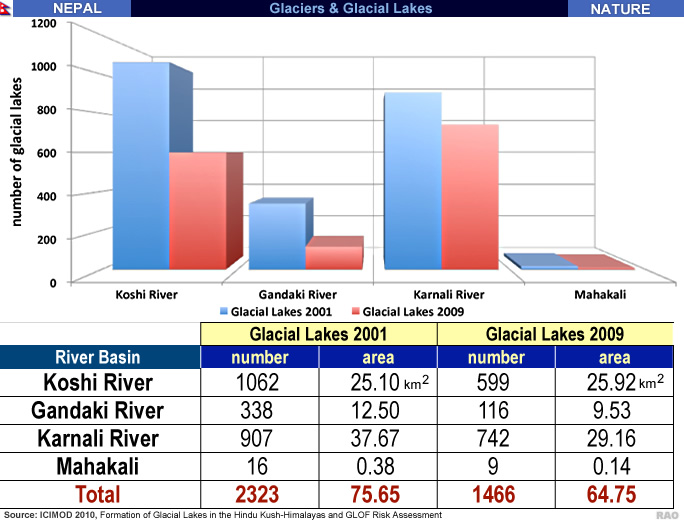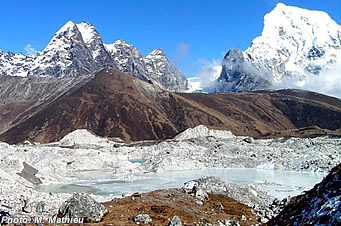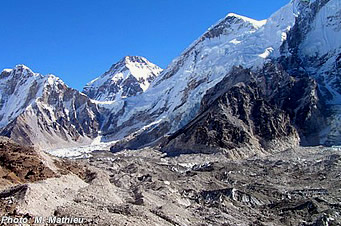 |
Nepal Himalayas Glaciers |
|
 |
Nepal Information |
|
|
 |
 |
|
Water
crisis looms as Himalayan glaciers retreat
|

|
Himalayan
glaciers are among the fastest retreating glaciers globally due to the
effects of global warming, and this will eventually result in water shortages
for hundreds of millions of people who rely on glacier-dependent rivers
in China, India and Nepal, warns WWF, the global conservation organisation.
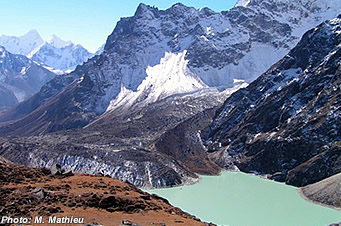 |
Chhukung (4730 m)
| A
new WWF report - An Overview of Glaciers, Glacier Retreat and Subsequent
Impacts in Nepal, India and China - reveals the rate of retreat of Himalayan
glaciers accelerating as global warming increases. The report states that
glaciers in the region are now receding at an average rate of 10-15 metres
per year.
"The
rapid melting of Himalayan glaciers will first increase the volume of water
in rivers causing widespread flooding," said Jennifer Morgan, Director
of WWF's Global Climate Change Programme. |
|
 |
Gokyo (4790 m)
"But in a few decades this situation
will change and the water level in rivers will decline, meaning massive
economic and environmental problems for people in Western China, Nepal
and Northern India."
A
new WWF report - An Overview of Glaciers, Glacier Retreat and Subsequent
Impacts in Nepal, India and China - reveals the rate of retreat of Himalayan
glaciers accelerating as global warming increases. The report states that
glaciers in the region are now receding at an average rate of 10.15 metres
per year.
|
|
"The
rapid melting of Himalayan glaciers will first increase the volume of water
in rivers causing widespread flooding," said Jennifer Morgan, Director
of WWF's Global Climate Change Programme. "But in a few decades this situation
will change and the water level in rivers will decline, meaning massive
economic and environmental problems for people in Western China, Nepal
and Northern India."
Himalayan
glaciers feed into seven of Asia's greatest rivers (the Ganges, Indus,
Brahmaputra, Salween, Mekong, YanGIZe and Huange He), ensuring a year-round
water supply to hundreds of millions of people in the Indian subcontinent
and China. As glacier water flows dwindle, the energy potential of hydroelectric
power will decrease causing problems for industry, while reduced irrigation
means lower crop production.
Nepal
has an annual average temperature rise of 0.06°C per year. The report
shows that three of Nepal's snow-fed rivers have shown declining trends
in discharge. In China, the report shows that Qinhai Plateau's wetlands
have seen declining lake water levels, lake shrinkage, the absence of water
flow in rivers and streams, and the degradation of swamp wetlands. In India,
the Gangotri glacier, which supports one of India's largest river basins,
is receding at an average rate of 23 metres per year.
The
report is released on the eve of a two-day ministerial roundtable of the
20 largest energy using economies in the world, including China and India,
followed by a G8 meeting of development and environment ministers focusing
on climate change and on Africa. Both meetings are hosted by the UK government
in London from 15-18 March. WWF has sent a letter to participating ministers,
stressing the need to recognize climate change as an issue that seriously
threatens security and development prospects.
"Ministers
should realize now that the world faces an economic and development catastrophe
if the rate of global warming isn't reduced," said Jennifer Morgan. "They
need to work together on reducing CO2 emissions, increasing the use of
renewable energy and implementing energy efficiency measures.".
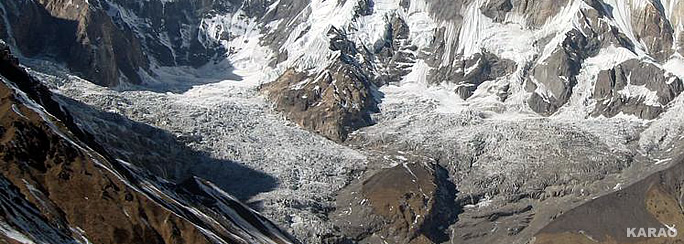 |
|
Glaciers
flowing down from Annapurna I |
 |
NOTES:
 In a letter to the Ministers of Environment, Energy and Development attending
the Ministerial roundtable and the G8 meeting, WWF calls on all governments
to recognize that global average temperature must stay below 2°C (3.6°F)
in comparison to pre-industrial levels, to agree upon a series of ambitious
initiatives to vastly change the way their countries produce and use energy,
and to launch a power sector governance initiative where all countries
commit to practicing the principles of transparency, accountability and
public participation in energy sector decision-making. The letter sent
by WWF International to the Development and Environment Ministers can be
made available on request. In a letter to the Ministers of Environment, Energy and Development attending
the Ministerial roundtable and the G8 meeting, WWF calls on all governments
to recognize that global average temperature must stay below 2°C (3.6°F)
in comparison to pre-industrial levels, to agree upon a series of ambitious
initiatives to vastly change the way their countries produce and use energy,
and to launch a power sector governance initiative where all countries
commit to practicing the principles of transparency, accountability and
public participation in energy sector decision-making. The letter sent
by WWF International to the Development and Environment Ministers can be
made available on request.
 The
countries participating in the 'Energy and Environment Ministerial Round
Table' include Australia, Brazil, Canada, China, France, Germany, India,
Indonesia, Iran, Italy, Japan, Korea, Mexico, Nigeria, Poland, Russia,
South Africa, Spain, the United Kingdom and the United States, as well
a the European Union. The countries underlined are part of the G8 group. The
countries participating in the 'Energy and Environment Ministerial Round
Table' include Australia, Brazil, Canada, China, France, Germany, India,
Indonesia, Iran, Italy, Japan, Korea, Mexico, Nigeria, Poland, Russia,
South Africa, Spain, the United Kingdom and the United States, as well
a the European Union. The countries underlined are part of the G8 group.
|
|
Source:
WWF Global Climate Change Programme
March
2005 |
top
|
Information |

|
| Snow, Ice, Glaciers, Glacial Lakes and Floods - Reports |
 |
| Himalayas |
 |
Snow, Ice, Glacier, Glacial Lakes and Floods Reports |
 |
 |
 |
External
link |
|




